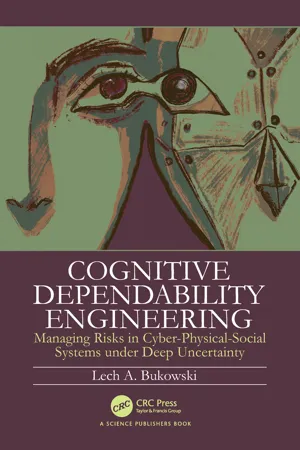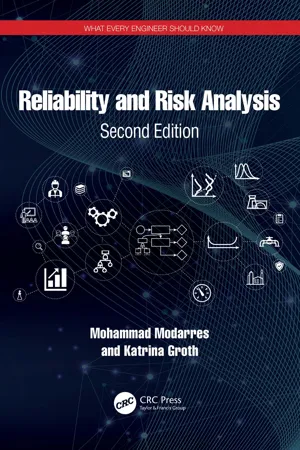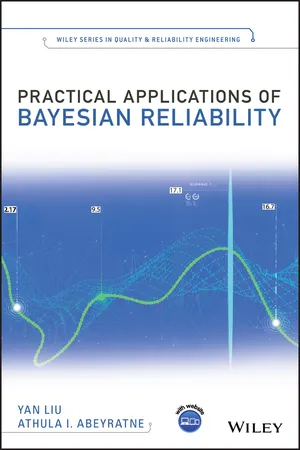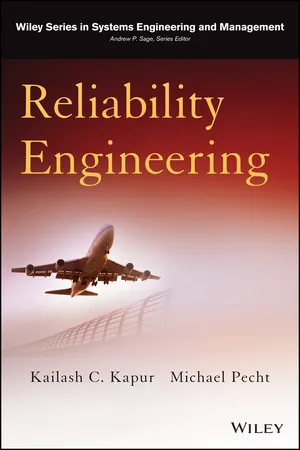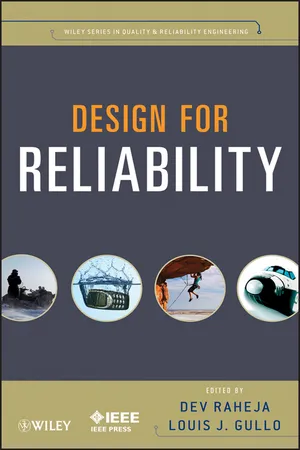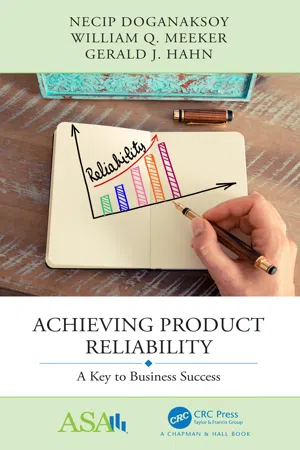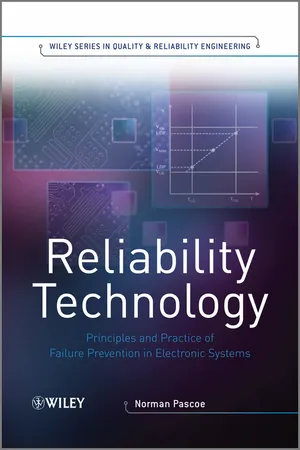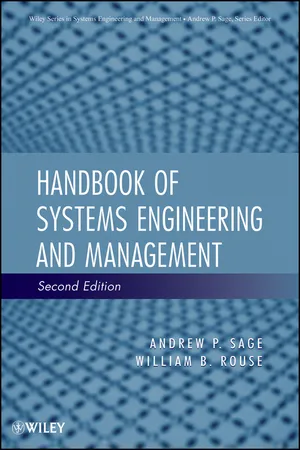Technology & Engineering
Reliability Engineering
Reliability engineering focuses on ensuring that systems, products, and processes perform their intended functions consistently and without failure over time. It involves identifying potential failure modes, analyzing their causes, and implementing strategies to prevent or mitigate them. By applying principles of reliability engineering, organizations can enhance the dependability and longevity of their technological assets.
Written by Perlego with AI-assistance
Related key terms
12 Key excerpts on "Reliability Engineering"
- eBook - ePub
Cognitive Dependability Engineering
Managing Risks in Cyber-Physical-Social Systems under Deep Uncertainty
- Lech Bukowski(Author)
- 2023(Publication Date)
- CRC Press(Publisher)
This chapter provides an overview of the major concepts that underpinned the emergence and dynamic development of Reliability Engineering as an interdisciplinary field of knowledge. Physical aspects of reliability are also discussed, as being particularly relevant to the engineering approach, and neglected in most works on Reliability Engineering. The mathematical basis for the evaluation of the reliability of elements and entire systems was presented, both based on mathematical statistics and on the theory of probability. Models of selected discrete probability distributions as well as continuous probability distributions were presented, and the calculation formulas necessary to determine the parameters of these distributions are summarized. Selected examples of metrics for reliability attributes have been proposed and illustrated with examples. The section on structural reliability discusses the Reliability Block Diagram method and its application to assess the reliability of systems with different functional structures. The computational models for selected redundant structures were presented, namely so-called (k, n) systems as well as with hot, warm, and cold reserve. The conclusion presents the limitations of the application of these theoretical models in real operating conditions.6.1 The Emergence and Development of Reliability Engineering
Generally, reliability can be considered as a time-oriented quality (O’Connor and Kleyner, 2012 ). Thus, it refers to the future performance or behaviour of a component or system. More precisely, reliability is the ability of a product or system to perform as intended (i.e., without failure and within specified performance limits) for a given time, in its lifecycle conditions (Kapur and Pecht, 2014 ). Reliability Engineering is a sophisticated interdisciplinary field which requires a wide-ranging body of knowledge in the basic sciences, including physics, chemistry, and mathematics, an understanding of the broader issues within system integration and engineering, as well as considering costs and schedules.Reliability Engineering as a scientific discipline was established in the mid-1950s. The formation of the Advisory Group on the Reliability of Electronic Equipment (AGREE) by the US Department of Defense in 1956 can be considered as the turning point in reliability development (Sage and Rouse, 1999 - eBook - ePub
- Mohammad Modarres, Katrina Groth(Authors)
- 2023(Publication Date)
- CRC Press(Publisher)
1 Reliability Engineering Perspective and Fundamentals
DOI: 10.1201/9781003307495-11.1 Why Study Reliability?
Structures, systems, and components designs are not perfect. While a naïve view would insist that it is technologically possible to engineer a perfect system and design out all failures, unfortunately, this view is idealistic, impractical, and economically infeasible. It is an essential job of engineers to prevent, mitigate, respond to, and recover from failures. Reliability Engineering helps ensure robust design, product reliability, and economic competitiveness. Beyond this, Reliability Engineering helps engineers achieve their duty to hold paramount the safety, health, and welfare of the public, workers, and the environment. Reliability Engineering and risk analysis are essential capabilities that enable us to uphold the integrity of the systems we design, build, operate, maintain, and ultimately attain the high integrity of the engineering profession.Myriad examples of engineering failures motivate the study of reliability. For instance, on March 11, 2011, an earthquake and tsunami induced a loss of reactor cooling at Japan’s Fukushima Daiichi nuclear power plant. This resulted in meltdown, evacuations, radiation release, and environmental contamination. The clean-up continued a decade later with a cost estimated to exceed $200 billion.Another example comes from the space sector: on February 1, 2003, the Space Shuttle Columbia disintegrated on reentry. The failure scenario was initiated when a small piece of foam insulation broke off during takeoff, causing damage that allowed hot gases to penetrate and destroy the wing. The failure led to the loss of all seven crew members, and the U.S. space shuttle program was halted for over 2 years while NASA investigated the accident and implemented new safety measures. While the Space Shuttle Columbia incident resulted in disaster, NASA was aware that problems with foam had been happening for years. More minor failures happen—and careful study of these is an opportunity to prevent catastrophic failure. - eBook - ePub
- Yan Liu, Athula I. Abeyratne(Authors)
- 2019(Publication Date)
- Wiley(Publisher)
1 Basic Concepts of Reliability Engineering This chapter reviews basic concepts and common Reliability Engineering practices in the manufacturing industry. In addition, we briefly introduce the history of Bayesian statistics and how it relates to advances in the field of Reliability Engineering. Experienced reliability engineers who are very familiar with reliability basics and would like to start learning Bayesian statistics right away, may skip this chapter and start with Chapter 2. Bayesian statistics has unique advantages for reliability estimations and predictive analytics in complex systems. In other cases, Bayesian methods may provide flexible solutions to aggregate various sources of information to potentially reduce necessary sample sizes and therefore achieve cost effectiveness. The following chapters provide more specific discussions and case study examples to expand on these topics. 1.1 Introduction High product quality and reliability are critical to any industry in today's competitive business environment. In addition, predictable development time, efficient manufacturing with high yields, and exemplary field reliability are all hallmarks of a successful product development process. Some of the popular best practices in industry include Design for Reliability and Design for Six Sigma programs to improve product robustness during the design phase. One core competency in these programs is to adopt advanced predictive analytics early in the product development to ensure first‐pass success, instead of over‐reliance on physical testing at the end of the development phase or on field performance data after product release. The International Organization for Standardization (ISO) defines reliability as the “ability of a structure or structural member to fulfil the specified requirements, during the working life, for which it has been designed” (ISO 2394:2015 General principles on reliability for structures, Section 2.1.8) - eBook - ePub
Practical Power Plant Engineering
A Guide for Early Career Engineers
- Zark Bedalov(Author)
- 2020(Publication Date)
- Wiley-IEEE Press(Publisher)
): A basic measure of maintainability: the sum of corrective maintenance times at any specified level of repair, divided by the total number of failures within an item repaired at that level, during a particular interval under stated conditions.- Mission reliability: The ability of an item to perform its required functions for the duration of specified mission profile.
- Reliability: (i) The duration or probability of failure‐free performance under stated conditions. (ii) The probability that an item can perform its intended function for a specified interval under stated conditions.
Engineers responsible for designing various engineering projects must incorporate Reliability Engineering into their plans and designs, including plant flow diagrams, procurement, operations, and maintenance. The most relevant and practical methods for plant Reliability Engineering, include- Basic reliability calculations for failure rate, MTBF, availability, etc.
- Exponential distribution.
- Field data collection.
21.2 Basic Reliability Engineering Concepts
A basic understanding of the fundamental and widely applicable methods [2 ] can enable the engineers to improve the manufacturing/production process by acknowledging the critical part of the production, the most failure of the prom equipment, and part of the line where the blockages occur, their nature and root causes, and impact on the production process. Following that understanding, the engineer will ascertain which equipment needs redundant drives, more spare parts, better protection from environment, or a change in the production technology to suit the raw materials used to make products.Let us look at one of the simplest and the most widely used reliability concepts and cost‐benefits of the reliability calculations.Suppose, a pumping system that is critical to your production is in a failed state 10% of time. It presently operates with a single pump. What would be an improvement if an additional pump is added in parallel with the present pump? If the system fails now at 10% of time and the system is made redundant, the failure rate would fall down to 0.1 × 0.1 = 0.01 (1%), which is an improvement of: (0.1/0.01) × 100 = 1000%. Well, it would be crazy not to improve the production line for an expenditure of $500. On the other hand, you would not want to spend money on a noncritical - eBook - ePub
- H. Lee Willis, Randall R. Schrieber(Authors)
- 2017(Publication Date)
- CRC Press(Publisher)
increases . In a system where SAIFI is expected to be .66, certain automated switching and fault location programs may not provide a benefit/cost ratio of 1.00 or more. There is not enough opportunity, in such a reliable system, for them to justify their expense. But if the SAIFI is 1.33, they are about twice as cost effective. Therefore, as a system ages and failure rates increase, the cost effectiveness of various reliability improvement methods gradually rises. And as more is spent to renew equipment, the cost effectiveness of reliability improvement methods drops.What a utility wants is the lowest cost way to deliver satisfactory service reliability to its customers. To the customer, it does not matter if that reliability comes from an a network composed of worn out equipment that is controlled smartly by an advanced monitoring and control system, or from a network that is inherently reliable because equipment condition is maintained at a high level. What is important is that: a) service is reliable, and b) cost is as low as possible. The industrial power owner seeks the same cost “sweet spot.”Not surprisingly, in every case, the lowest cost, lowest risk plan is always a combination of both approaches, something that basically picks the low hanging fruit from each method in order to provide just enough reliability to satisfy needs. Thus, Reliability Engineering – planning, specification, and implementation of measures to improve and control customer reliability – is an important aspect of planning for aging infrastructures. The other part is the planning of the best inspection, tracking, condition improvement, life extension, proactive replacement plan. The two interact, creating synergy if used together well and problems if not, so they must be planned in conjunction with one another.Reliability Engineering of Power Delivery
This chapter summarizes power delivery reliability concepts and methods.The goal of reliability-based planning, engineering, and operations is to cost effectively maximize reliability of service as seen by the customer, not necessarily to improve reliability of equipment or service time on the system. Customer-level results are what count. - eBook - ePub
- Kailash C. Kapur, Michael Pecht(Authors)
- 2014(Publication Date)
- Wiley(Publisher)
1 Reliability Engineering in the Twenty-First CenturyInstitutional and individual customers have increasingly better and broader awareness of products (and services) and are increasingly making smarter choices in their purchases. In fact, because society as a whole continues to become more knowledgeable of product performance, quality, reliability, and cost, these attributes are considered to be market differentiators.People are responsible for designing, manufacturing, testing, maintaining, and disposing of the products that we use in daily life. Perhaps you may agree with Neville Lewis, who wrote, “Systems do not fail, parts and materials do not fail—people fail!” (Lewis 2003) It is the responsibility of people to have the knowledge and skills to develop products that function in an acceptably reliable manner. These concepts highlight the purpose of this book: to provide the understanding and methodologies to efficiently and cost effectively develop reliable products and to assess and manage the operational availability of complex products, processes, and systems.This chapter presents the basic definitions of reliability and discusses the relationship between quality, reliability, and performance. Consequences of having an unreliable product are then presented. The chapter concludes with a discussion of supplier–customer reliability objectives and responsibilities.1.1 What Is Quality?
The word quality comes from the Latin qualis, meaning “how constituted.” Dictionaries define quality - eBook - ePub
Functional Safety of Machinery
How to Apply ISO 13849-1 and IEC 62061
- Marco Tacchini(Author)
- 2023(Publication Date)
- Wiley(Publisher)
1 The Basics of Reliability Engineering1.1 The Birth of Reliability Engineering
[EN 764‐7] [20] 3 Terms and definitions3.14 Reliability. Ability of a system or component to perform a required function under specified conditions and for a given period of time without failing.The first Reliability models appeared during World War I, and they were used in connection with airplane performances: the Reliability was measured as the number of accidents per hour of flight time.In the 1930s, the Reliability concepts and statistical methods were used for quality control of industrial products and, in the 1940s, to analyze the missile system during World War II. At that time, Robert Lusser, a mathematician, established the so‐called “Product probability law of series components.”Lusser discovered that the Reliability of a system is equal to the product of the reliabilities of the individual components which make up the system. If the system has many components, the system Reliability may therefore be rather low, even though the individual components have high Reliability values.After the war, the interest in the United States was concentrated on intercontinental ballistic missiles and space research; this led to the creation of an association for engineers working with Reliability. The first journal on the subject, “IEEE Transactions on Reliability” came out in 1963, and several textbooks on the subject were published in that decade. The famous military standard MIL‐STD‐781 was created at that time. Around that period, also the much‐used predecessor to military handbook 217 was published by RCA, Radio Corporation of America, and was used for the prediction of failure rates of electronic components.In the following years, more pragmatic approaches were developed and used in the consumer industries. Reliability tools and tasks became more closely tied to the engineering design process - eBook - ePub
- Dev G. Raheja, Louis J. Gullo, Dev G. Raheja, Louis J. Gullo(Authors)
- 2012(Publication Date)
- Wiley(Publisher)
So it makes sense that for the design function to meet reliability requirements, reliability must be specified and estimated. The first action of Reliability Engineering in a product's design life is to facilitate the definition of the reliability goal or specification and to estimate whether or not the requirement is easy, difficult, or impossible. This is done with an understanding of the design's purposes, its uses and limitations, its environments, its architecture, and the time it is intended to last. Predictions and models are used to estimate the likelihood that the design will be capable of meeting the reliability requirements. Further in the design process, other methods are used to understand which parts of a design are most sensitive to reliability and what changes might affect the reliability the most. Analyses that lead to understanding stresses—mechanical, thermal, and electrical—are performed; reliability block diagrams and predictions are completed to provide the numerical status of the design. Testing is where the “rubber meets the road” not only for the obvious design parameters, but where the weak points are regarding reliability—be they due to design concerns, manufacturing problems, or testing issues. There are specific design tests that are used in testing exemplar units to provide insight into the design margins, while other screen tests assure that a minimum amount of quality and reliability are included for each finished product. Root-cause analyses, fault trees, and data analysis tools are used to detect test result concerns, as well as causes for failures. Similarly, such tools are also used for defining issues and possible causes during production and use in the field. Often, designs must undergo modifications due to changes in requirements or obsolescence of parts - eBook - ePub
Patterns In Safety Thinking
A Literature Guide to Air Transportation Safety
- Geoffrey R. McIntyre(Author)
- 2017(Publication Date)
- Routledge(Publisher)
Modarres provided an introduction and explanation of the practical methods used in reliability and risk studies, and discussion of their use and limitations. For Modarres, "Reliability" has dual meanings: probabilistic and deterministic. In discussing the probabilistic nature of "Reliability," he offers the definition that it is the ability of an item (product, system etc.) to operate under designated operating conditions for a designated period of time. The ability of an item can be designated through a probability, or can be designated deterministically. Deterministic analysis deals with understanding how and why failure occurred and how it can be designed and tested to prevent its re-occurrence. It includes an understanding of the physics of failure and the role of testing and redesign. 6 Leveson offers the following definitions: Reliability is the probability that a piece of equipment or component will perform its intended function satisfactorily for a prescribed time and under stipulated environmental conditions. Failure is the nonperformance or inability of the system or component to perform its intended function for a specified time under specified environmental conditions. 7 Reliability Engineering received increased emphasis with the rapid Cold War growth of military aircraft and missile systems development and became increasingly important to commercial-aircraft manufacturers. Reliability estimates (expressed as Mean Time To Failure, MTTF, and Mean Time Between Failure, MTBF) for the three basic subsystems of an aircraft: the structure, the propulsion, and the avionics have been satisfactorily developed - eBook - ePub
Achieving Product Reliability
A Key to Business Success
- Necip Doganaksoy, William Q. Meeker, Gerald J. Hahn(Authors)
- 2021(Publication Date)
- Chapman and Hall/CRC(Publisher)
- Elementary probability theory lets us compute the reliability of simple systems from the reliability of the components that make up the system. This allows engineers to obtain an initial quantification of system reliability from the system structure and the individual component reliabilities.
- More complex statistical or simulation tools may similarly be used to calculate system reliability for more complex systems.
- Redundancy in design may be used to improve system reliability and its impact evaluated using simple or, as needed, more advanced techniques.
- The preceding methods are also employed in assessing the impact of the removal of specified failure modes and assessing the reliability of different size systems.
References and Additional Resources
• System reliability modeling:- Ebeling, C.E. (2010). An Introduction to Reliability and Maintainability , Second Edition, Waveland Press.
- Modarres, M., M. Kaminskiy, and V. Krivtsov (2017). Reliability Engineering and Risk Analysis: A Practical Guide , Third Edition, CRC Press.
- O’Connor, P.D.T., and A. Kleyner (2012). Practical Reliability Engineering , Fifth Edition, Wiley.
- Yang, G. (2007). Life Cycle Reliability Engineering , Wiley.
- Peter, A., D. Das, and M. Pecht (2015). “Critique of MIL-HDBK-217,” Appendix D in Reliability Growth: Enhancing Defense System Reliability. Panel on Reliability Growth Methods for Defense Systems , Committee on National Statistics, Division of Behavioral and Social Sciences and Education, The National Academies Press.
- Wikipedia Contributors, “United Airlines Flight 232,” Wikipedia
- eBook - ePub
Reliability Technology
Principles and Practice of Failure Prevention in Electronic Systems
- Norman Pascoe(Author)
- 2011(Publication Date)
- Wiley(Publisher)
Chapter 7 Essential Reliability Technology Disciplines in Design “Design is not just what it looks like and feels like. Design is how it works”. Steve Jobs 1955 7.1 OverviewOEMs that specialise in particular product applications are likely to have built a substantial data base from which to define detailed requirement specifications for new products. Typical of such product applications are automotive, computer, telecom., medical and aerospace to name but a few. These OEMs will have learned a great deal about the less obvious whole-life environmental factors that influence the operational reliability of their products. In spite of the leverage gained from such experience, it is not uncommon for design requirement specifications to be devalued by the imposition of environmental standards that are inappropriate to both product-performance requirements and whole-life environmental-exposure expectation. The ability to create an acceptable functional design is usually far easier to recognise than the ability to create a robust and durable design. Failure to create a reliable hardware design is often exacerbated by the imposition of an ill-considered project-funding profile. It is not uncommon for a design-phase activity to be grossly underfunded, and for operation/support costs to be unacceptably high. Typical of such poorly judged lifecycle cost profiles are the two medium- (M) and two high- (H) volume electronic systems taken from real-life case studies and shown in Table 7.1 .Table 7.1 Comparison of Percentage Lifecycle Costs for Four Different Projects.All operation and support costs have to be extracted from revenue. Some companies allocate fifteen to twenty per cent of projected lifecycle costs to operation and support without giving careful consideration to the scope of work required to identify a corresponding design strategy that will form the foundation of a truly reliable product. The entire spectrum of inevitable whole-life environmental-stress categories and magnitudes for a new product must be recognised, acknowledged and allowed for as part of the concept/feasibility phase before the commencement of the design phase. All the accelerated testing and statistical models in the world will not compensate for an ill-conceived design. If development testing indicates the need to redesign a product, it is unlikely to be achieved for ten to fourteen per cent of the lifecycle cost budget. There is no benefit to be gained from putting on protective clothing after you have developed frost bite. - eBook - ePub
- Andrew P. Sage, William B. Rouse(Authors)
- 2011(Publication Date)
- Wiley-Interscience(Publisher)
8 Reliability, Maintainability, and Availability MICHAEL PECHT 8.1 INTRODUCTION AND MOTIVATIONReliability, maintainability, and availability (RMA) engineering is a discipline in which data are gathered and models are formulated to make decisions concerning system failure, operational readiness and success, maintenance and service requirements, and the collection and organization of information from which the effectiveness of a system can be evaluated and improved. RMA engineering thus includes engineering design, manufacturing, testing, and analysis. RMA metrics can be considered to be characteristics of a system in the sense that they can be estimated in design, controlled in manufacturing, measured during testing, and sustained in the field (Pecht, 1995).When utilized early in the concept development stage of a system’s development, RMA serves to determine feasibility and risk. In the design stage of system development, RMA analysis involves methods to enhance performance over time through the selection of materials, design of structures, choice of design tolerances, manufacturing processes and tolerances, assembly techniques, shipping and handling methods, and maintenance and maintainability guidelines. Engineering concepts such as strength, fatigue, fracture, creep, tolerances, corrosion, and aging play a role in these design analyses. The use of physics-of-failure concepts coupled with the use of factors of safety and worst case studies are often required to understand the potential problems, trade-offs, and corrective actions. In the manufacturing stage of a system, RMA analysis involves determining quality control procedures, reliability improvements, maintenance modifications, field testing procedures, and logistics requirements. In the system’s operational phases, RMA involves safety inspection, failure analysis, maintainance, and logistical support.
Index pages curate the most relevant extracts from our library of academic textbooks. They’ve been created using an in-house natural language model (NLM), each adding context and meaning to key research topics.
